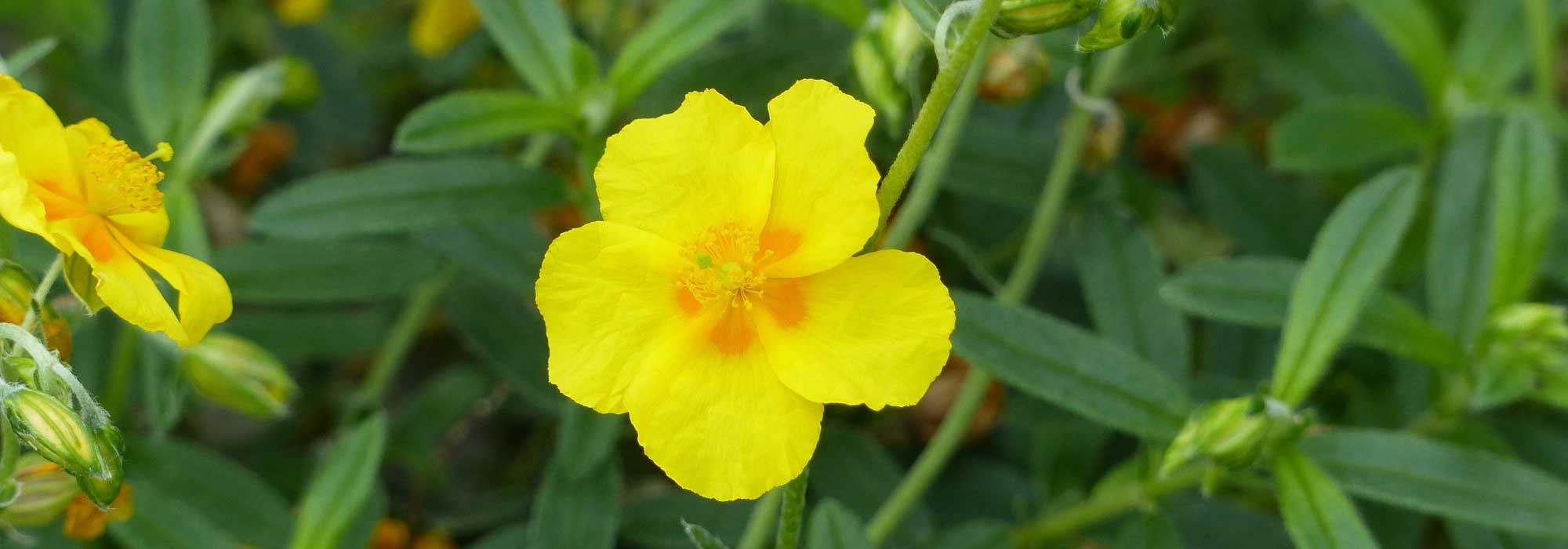
Helianthemum: planting, growing tips
Contents
Helianthemum in a nutshell
- Hélianthème is the miniature cousin of Cistus, even hardier!
- It forms a very floriferous dwarf shrub with evergreen or semi-evergreen silver or green leaves
- From spring to autumn, it offers a profusion of flowers light as crumpled bristle: pastel pink, cherry-red, sulphur-yellow, white or orange
- Used to garrigues, it shoots in full sun and only in well-drained, rather calcareous soil
- Carefree shrub, ultra-robust, essential for brightening a dry, gravel garden, in rockery, border or even in pots
A word from our expert
If, for plant enthusiasts, Helianthemum conjures a small bush of the garrigue very closely related to Cistus, for others this “flower of the sun” brings to mind a caterer, a range of natural products or an organic shop in La Rochelle!
From April to September, with its delicate crumpled flowers, this sometimes very mat-forming bush brings freshness or vivacity to a limestone garden, or to a mineral one.
Red, pink, yellow or white Helianthemums are all worth adopting for their generous flowering and great ease of care.
Hardy down to -20°C, it thrives in full sun and favours stony gardens and arid soils where few plants will grow and in which it proves very undemanding.
Discover our Helianthemums and their many colourful cultivars, these very floriferous dwarf bushes, essential both as a rockery plant and as groundcover, in borders or in pots!
Description and botany
Botanical data
- Latin name Helianthemum
- Family Cistaceae
- Common name Helianthemum
- Flowering April–May to September
- Height 0.15 to 0.50 m
- Exposure Sun
- Soil type calcareous, neutral, well-drained
- Hardiness -15°C-20°C
Belonging to family Cistaceae, like cistus, Helianthemum is an undershrub living in alpine and rocky meadows, up to 1,500 m altitude, native to America, Europe and Mediterranean rim, notably Balearic Islands.
Genus Helianthemum includes more than a hundred species that have produced numerous hybrids, mainly from Helianthemum nummularium (common Helianthemum) and Helianthemum appeninum. In gardens, botanical species are seldom grown and mostly their countless colourful cultivars are seen — white, orange, ruby or red such as ‘Hartswood Ruby’, pinks, or yellows such as ‘Whisley Primrose’.
Of normal growth, it forms a small bushy plant of fine woody branches, with a very spreading habit, sometimes very low, in a cushion 20 to 40 cm high, able to spread over soil up to 80 cm.
Foliage is evergreen or semi-evergreen in very cold areas, made of tiny leaves 0.5 to 5 cm long, opposite, oblong, linear, borne on downy shoots.
Foliage covered with small white hairs underneath or slightly glossy is most often a beautiful silvery-green, sometimes rather light green.
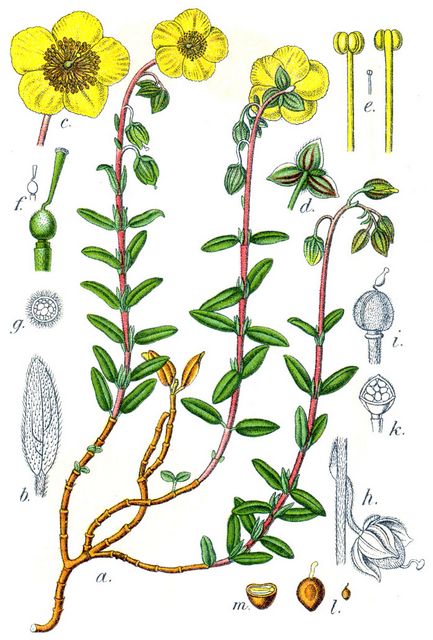
Helianthemum nummularium – botanical illustration
This ash-tinted vegetation highlights abundant, luminous summer flowering. The bush then becomes covered with a profusion of flowers renewed from April–May to September. Grouped in cymes at shoot tips, flower buds inclined towards ground open into small, flat, cup-shaped flowers, single or double 0.5 cm to 3 cm across. They consist of five silky petals, slightly crinkled like tissue paper, adorned with a broad halo and contrasting macules around a core of golden to orange stamens.
Flowers close in late afternoon, opening only in strong sunshine, which earned Helianthemum its nickname “sun flower”, unless name refers to typically golden-yellow or sulphur-yellow colouring.
Following successful hybridization, cultivars now display shades from pure white to ruby or cherry red, passing through all tones of pink or orange.
This silk-like flowering is ephemeral: Helianthemum’s fugacious flowers live only a few days but are continuously replaced by others throughout summer.
This constant renewal attracts bees, butterflies and other pollinating insects.
Very easy to grow and low-maintenance, Helianthemum is hardy and tolerates cold of -15°C to -20°C. An undershrub of stony garrigue par excellence, it grows on poor, dry, rocky, well-drained ground, where water does not stagnate. Drought- and salt-wind-resistant, it requires full sun and a warm position.
This dry rock garden plant is also perfect for flowering a sunny bank, topping a wall, filling gaps in paving, a border or a perennial bed. Helianthemum is often used for creating living walls. Growing in pots or tubs on a well-exposed terrace or balcony also suits it very well.

Some Helianthemum flowers: H. ‘Tomato Red’, H. ‘Hartswood Ruby’, H. ‘Ben Hope’, H. ‘Elfenbeinglanz’, H. ‘Ben Fhada’
Read also
Planting Perennials and BushesMain species and varieties
If helianthemum species number nearly a hundred, in gardens we mainly encounter hybrids of the Apennine helianthemum (Helianthemum appeninum) and the common helianthemum (Helianthemum nummularium), all very interesting for rockeries in dry gardens.
While most botanical helianthemums bear white or vivid sulphur-yellow flowers, their many cultivars now offer a very colourful palette ranging from pastel pink to cherry-red or orange.
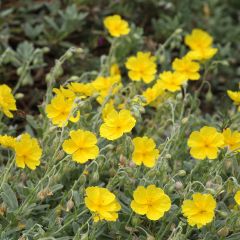
Helianthemum Wisley Primrose - Rock Rose
- Flowering time June to August
- Height at maturity 25 cm

Helianthemum Ben Fhada - Rock Rose
- Flowering time June to September
- Height at maturity 20 cm
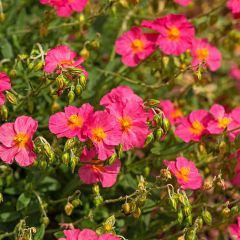
Helianthemum Ben Hope - Rock Rose
- Flowering time July to September
- Height at maturity 20 cm
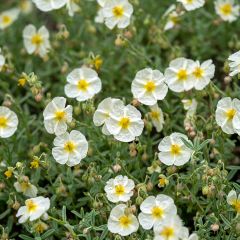
Helianthemum The Bride - Rock Rose
- Flowering time June to September
- Height at maturity 20 cm
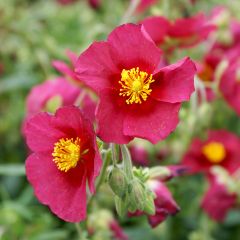
Helianthemum Hartswood Ruby - Rock Rose
- Flowering time June to September
- Height at maturity 20 cm
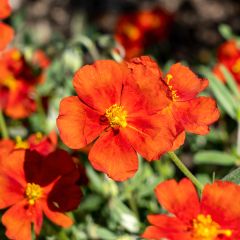
Helianthemum Tomato Red - Rock Rose
- Flowering time June to September
- Height at maturity 25 cm
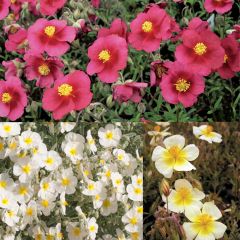
Selection of 6 rock roses
- Flowering time June to September
- Height at maturity 20 cm
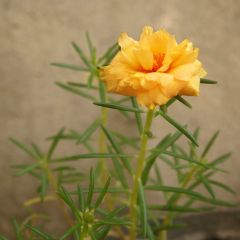
Helianthemum Orange Double - Rock Rose
- Flowering time June to September
- Height at maturity 15 cm
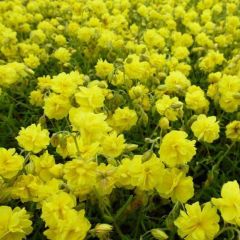
Helianthemum Sulphureum Plenum - Rock Rose
- Flowering time June to September
- Height at maturity 15 cm
Discover other Helianthemum
View all →Available in 2 sizes
Available in 0 sizes
Available in 1 sizes
Available in 0 sizes
Available in 1 sizes
Available in 2 sizes
Available in 1 sizes
Available in 1 sizes
Available in 1 sizes
Available in 1 sizes
Planting
Where to plant Helianthemum?
Helianthemum is a typically Mediterranean undershrub that grows naturally in dry, warm climate and tolerates sea spray well. It therefore copes easily with hot, south-facing situations. However, unlike its cousin the Cistus, it withstands cold down to -15° to -20°C and can be grown in all regions.
Conversely, it dislikes heavy, waterlogged soil in winter, compact soils in which it will not survive.
Plant in full sun, in preferably calcareous, perfectly drained soil where water never stagnates.
It is the plant par excellence for rock gardens. Alone or in groups, it is used in perennial beds, in borders, rockeries or as groundcover along paths or on a low wall or to brighten a paved area. Cultivation in large pots or window boxes is possible on terraces. It is also useful for creating green walls and green roofs.
When to plant Helianthemum?
Planting Helianthemum is done in spring, March–April after last frosts or in autumn, from September to November.
How to plant a Helianthemum?
If your soil retains moisture, lighten it with a few handfuls of gravel, some humus and sand and plant your Helianthemum on top of a small mound where water will not stagnate. For group planting, allow about 7 plants per m2 and space them roughly 0.40 to 0.60 m apart.
- In ground
- Dig a hole 2 to 3 times the volume of the rootball
- Lay a thick bed of gravel at bottom of hole
- Plant the bush at collar level
- Backfill hole with a mix of compost or potting soil and coarse sand, keeping the bush upright
- Firm gently with foot
- Water well
Planting Helianthemum in a pot
Place Helianthemum in full sun in a pot at least 50 cm in diameter and in a very free-draining mix to avoid stagnant moisture at roots.
- Spread a good drainage layer (gravel or clay balls) at bottom of container
- Plant in a mix of good garden soil, sand and fine gravel
- Water occasionally, allowing substrate to dry out between waterings
→ Discover our advice sheet on growing Helianthemum in pots
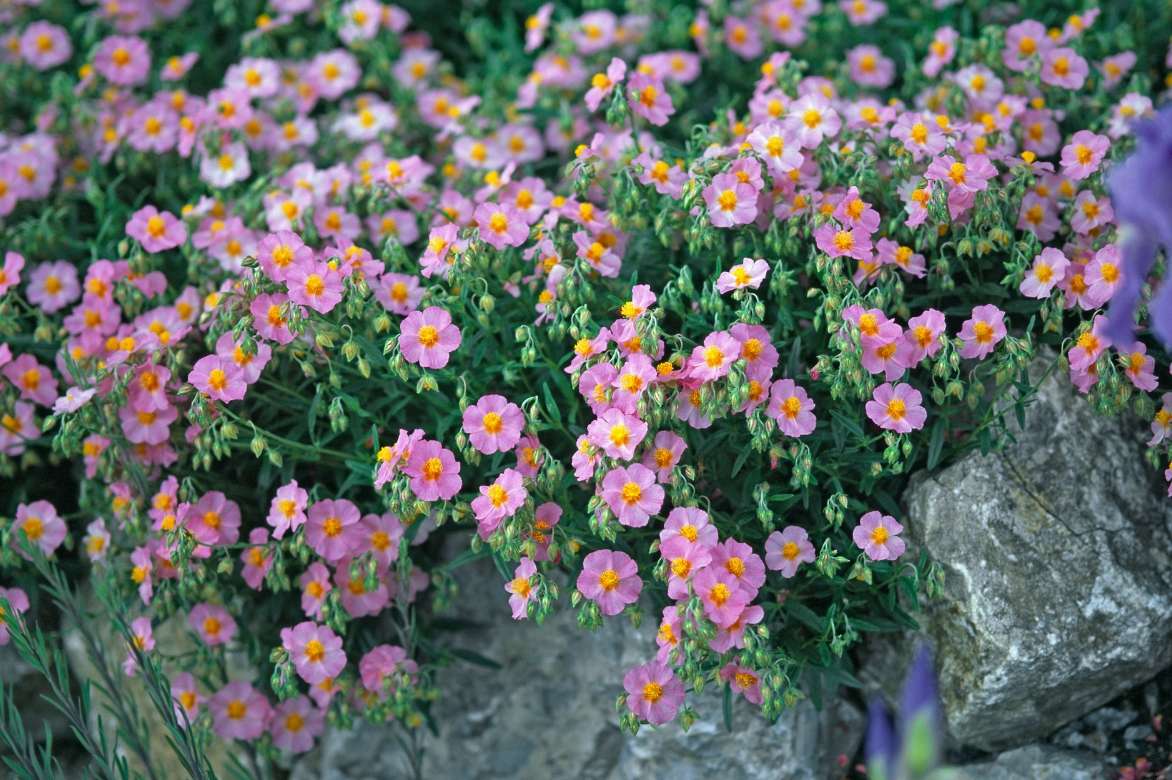
Helianthemum ‘Lawrensons Pink’ on a low wall (photo Friedrich Strauss – MAP)
Maintenance, pruning and care
Low-maintenance when well established in perfectly drained soil, Helianthemum is undemanding.
Well suited to sun and drought-hardy, it tolerates long periods of aridity: it’s the ideal shrub in dry, no‑irrigation gardens and gardens at holiday homes.
In open ground, it requires only regular, moderate watering during first year after planting.
Once well established, water only during prolonged drought.
Helianthemum in pots needs more frequent watering, especially in hot weather.
At end of summer, pinch off faded flower stems ; you will encourage reflowering.
When and how to prune a Helianthemum?
Although not essential, pruning Helianthemum is recommended to maintain balanced, bushy habit, regenerate foliage and prevent centre of branches becoming bare.
Prune after flowering, in September–October, to perform a light cutting back of the clump: prune to about 2 cm from old wood using a hedge shear.
Possible pests and diseases
Beneath apparent delicacy lies robustness to spare. Helianthemum only dislikes damp conditions.
In poorly drained soil it may suffer from fungal diseases caused by excess water in the soil: if your ground retains water, plant it on a raised mound and ensure drainage is properly managed; this will limit the development of fungi.
Multiplication
If Helianthemum can be multiplied by sowing in spring under cover, the simplest technique is propagation by cuttings in summer.
How to take Helianthemum cuttings
- In May–June, take herbaceous cuttings (still green) 10 cm long just below a node from stems without flowers or flower buds
- Remove lower leaves
- Insert them into individual buckets filled with a mixture of sand and potting compost
- Keep substrate slightly moist at all times
- Place in partial shade
- Plant out in ground next spring
Pair Helianthemum with other plants in the garden
Essential in a dry, mineral garden, Helianthemum brings colour and density to perennial borders, to the front of a bed, and of course to rockeries alongside other ground-cover perennials that enjoy sun.
Helianthemum is ideal in a scree garden or on scree slopes, alongside other Mediterranean bushes such as cistus and ceanothus or with sun-loving perennials.
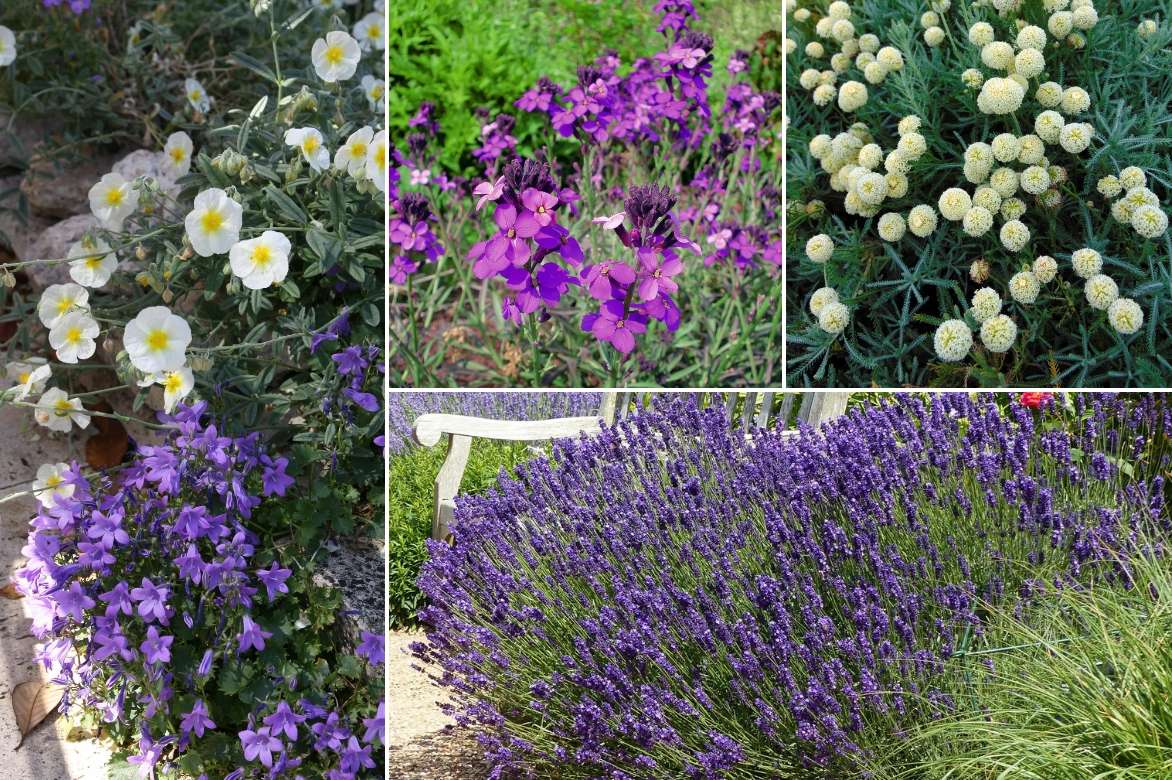
Idea for a pairing in dry, stony soil: Helianthemum ‘The Bride’, Campanula portenschlagiana, Erysimum ‘Bowles mauve’, Santolina chamaecyparissus ‘Edward Bowles’ (PAP photo), Lavandula angustifolia ‘Hidcote’
It suggests pairings in shades of yellow, white and silver, contrasting marriages of blue/yellow or pastel harmonies in a white garden or romantic garden.
In an evergreen border with garrigue accents, surround Helianthemum with lavender, creeping junipers, santolinas, and aromatic perennials such as creeping rosemary, thyme and sages.
Pair Helianthemum with other rockery perennials such as Erigerons, sedums, St John’s wort, pinks, wallflower and shrubby sages, plus hardy geranium.
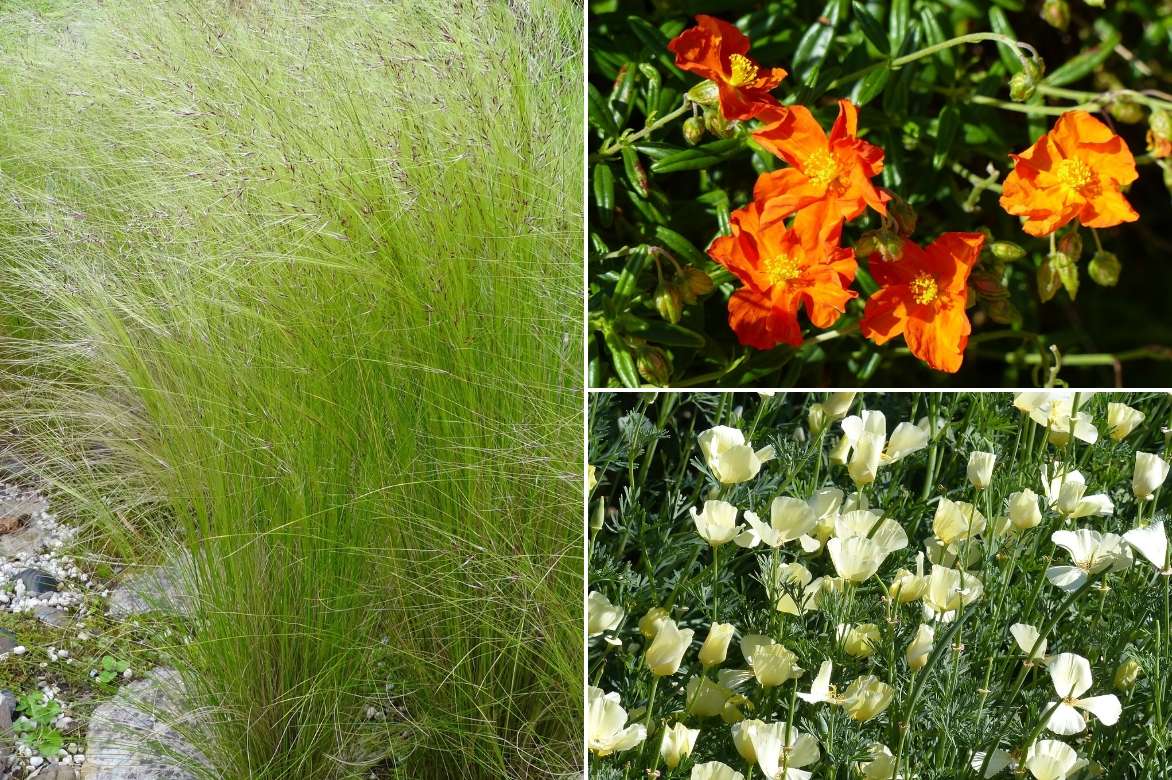
More contemporary pairing: Stipa tenuifolia, Helianthemum ‘Ben Mohr’ (another similar variety: H. Orange Double), Eschscholtzia californica (or ‘Peach Sorbet’, or ‘Buttermilk’)
In a lush border of varied tones, surround Helianthemum with California poppies, blue thistles, Agapanthus, Coreopsis, nepetas, summer alliums, love-in-a-mist, iris and euphorbias for dry ground.
Its delicate flowers pair perfectly with glaucous or grey foliage of Stachys, lamb’s ears, Artemisia, a silver Convolvulus, hardy geranium cinereum and Ballota.
Pink-flowered Helianthemums harmonise with cool tones of sedums, small scabious (Knautia macedonica), Lysimachia or Lychnis.
→ Discover other pairing ideas with Helianthemum in our advice sheet.
Useful resources
- Which plants to grow in calcareous soil?
- Hélianthème is the essential plant for creating low-maintenance borders
- What to plant in dry soil?
- Bring pink into the garden with our hélianthèmes with pink flowers!
- Our advice sheets: Pairing hélianthèmes, Hélianthème, the most beautiful varieties, Choosing a Hélianthème
- Subscribe!
- Contents
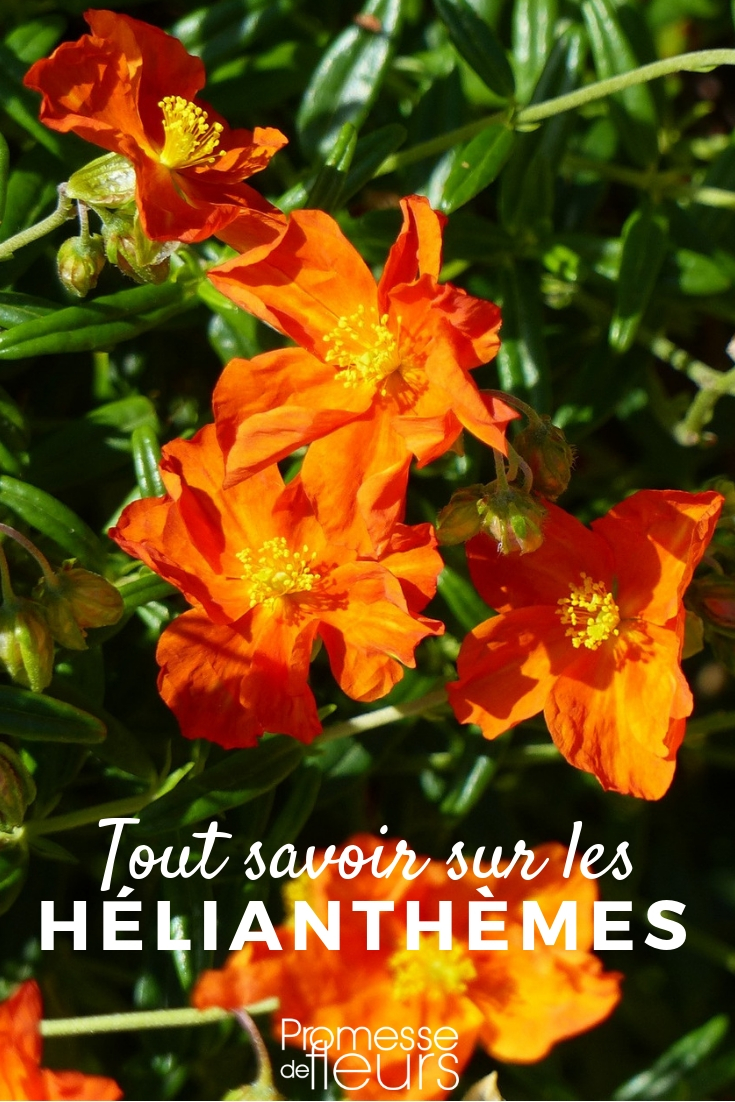


































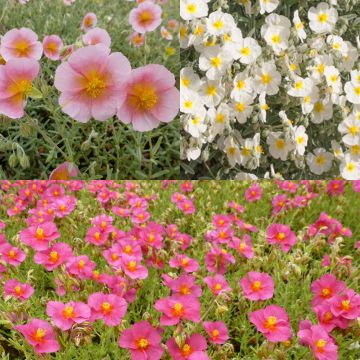
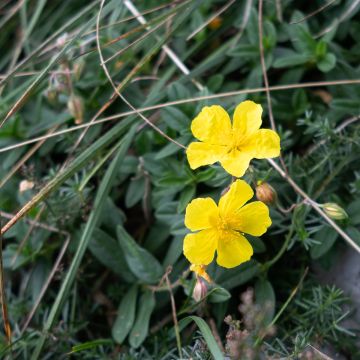

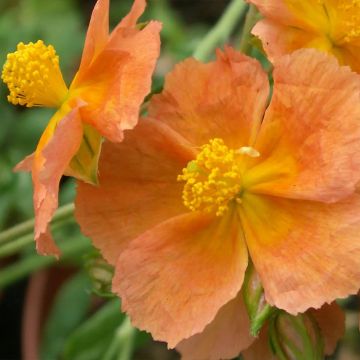
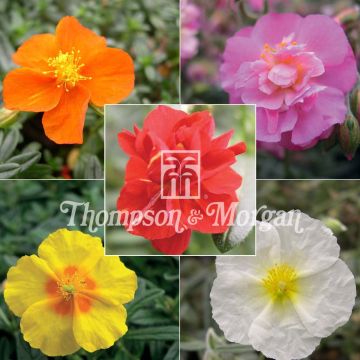
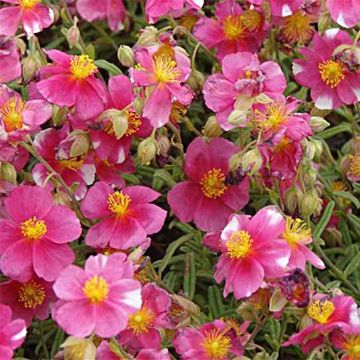

Comments